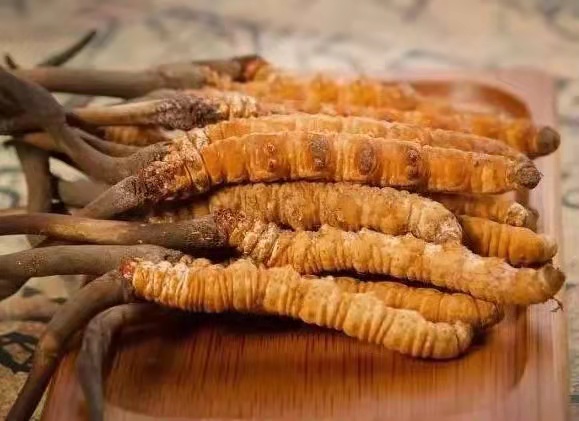Scientific research team realizes artificial high-density cultivation of Cordyceps sinensis

"Look, this is the fruiting body of Cordyceps sinensis, which is the 'grass' part of Cordyceps sinensis." On February 11, in a laboratory in the center of Chengdu, Chen Yulong, an associate researcher at the Sichuan Academy of Forestry Sciences, picked up a culture bottle,He showed reporters his latest research results - high-density cultivation of Cordyceps sinensis fruiting bodies, "In this small bottle you see now, there are 30 roots, and we can cultivate up to 100 roots."
As a high-end Chinese medicinal material, Cordyceps sinensis mostly comes from the wild environment in the alpine mountainous area. Chen Yulong spent more than ten years of research time successfully making this rare Chinese medicinal material able to be cultivated on a large scale in the plain area.
In fact, in China, the whole grass of Cordyceps sinensis has been fully artificially cultivated. However, it can only achieve an annual output of 2-300 pieces per square meter, and the overall price is relatively high. Only one domestic enterprise can cultivate it on a large scale. Under artificial breeding conditions, it still cannot meet the public's demand for Cordyceps sinensis consumption.
Different from the previous artificial cultivation, this time, Chen Yulong's team achieved two new breakthroughs in the artificial cultivation of Cordyceps sinensis.
The first is to realize the artificial cultivation of fruiting bodies.
What is a sub-entity? Mushrooms are the fruiting bodies of fungi. In a sense, Cordyceps sinensis is a special kind of mushroom, or a unique fungus called Trichosporium chinensis. After infecting bat moth larvae (worms), after the fruiting bodies grow on the worms,the whole is called Cordyceps sinensis.
Chen Yulong told reporters that the worms only provide nutrients for the fungus. In the final growth stage of Cordyceps sinensis, all the nutrients of the worms will be concentrated and supplied to the fruiting bodies, so that the Cordyceps sinensis can bloom and produce offspring. The grass head growing on the worm body is the fruiting body of Cordyceps sinensis, which has the unique medicinal effect of Cordyceps sinensis. According to the current Pharmacopoeia standard of the People's Republic of China, the active ingredient index of the fruiting body of Cordyceps sinensis is more than 3 times higher than that of the whole plant, and 4-6 times that of the worm body.
Therefore, in the field of scientific research, the cultivation of the fruiting body of Cordyceps sinensis has become the direction of research without relying on bat moth larvae (worms).
Although the fruiting body of Cordyceps sinensis has so many advantages, it is extremely difficult to cultivate. "The research requirements are extremely high, and it has been difficult to meet the technical requirements of large-scale production for decades." Chen Yulong told reporters that some researchers began to take a second place and choose the fruiting bodies of other insect-borne fungi to cultivate to meet the needs of the public.Since the 1980s, the cultivation of simple fruiting bodies of Cordyceps militaris, such as Cordyceps militaris and Cordyceps flowers, has become its substitute and entered thousands of households, forming an industry of 10 billion yuan.
In 2007, Chen Yulong began to study the cultivation of Cordyceps sinensis fruiting bodies. It took 2 years to isolate the first Cordyceps sinensis strain, and 5 years to collect Cordyceps sinensis from important producing areas in the province for research, and finally cultivated the first Cordyceps sinensis in 2018. A fruiting body of Cordyceps sinensis.
The second major breakthrough is the realization of high-density artificial cultivation of fruiting bodies. High-density cultivation technology enables the annual output of fruiting bodies per square meter to reach 80,000.
After a lot of experiments, in 2021, the team finally realized the high-density indoor cultivation technology of Cordyceps sinensis. The cultivation period is 5 to 7 months, and the annual output of fruiting bodies per square meter reaches 80,000. The color and length of the cultivated fruiting bodies can be controlled. The appearance is no different from wild Cordyceps sinensis.
"According to records, no one has cultivated such a high density of Cordyceps sinensis fruiting bodies." Chen Yulong told reporters that the fruiting bodies of Cordyceps sinensis cultivated by the research results have the advantages of low cost, fast growth, large yield, no heavy metal pollution, and no microbial pollution.
Moreover, because Cordyceps sinensis has the best effect of normal temperature clothing, but currently Cordyceps sinensis does not meet the standard of normal temperature clothing. The cultivated fruiting body of Cordyceps sinensis has no disadvantages such as microbial pollution and heavy metal pollution of wild Cordyceps sinensis, and can be taken directly at room temperature.

(1)(1).jpg)
 CONTACT
CONTACT